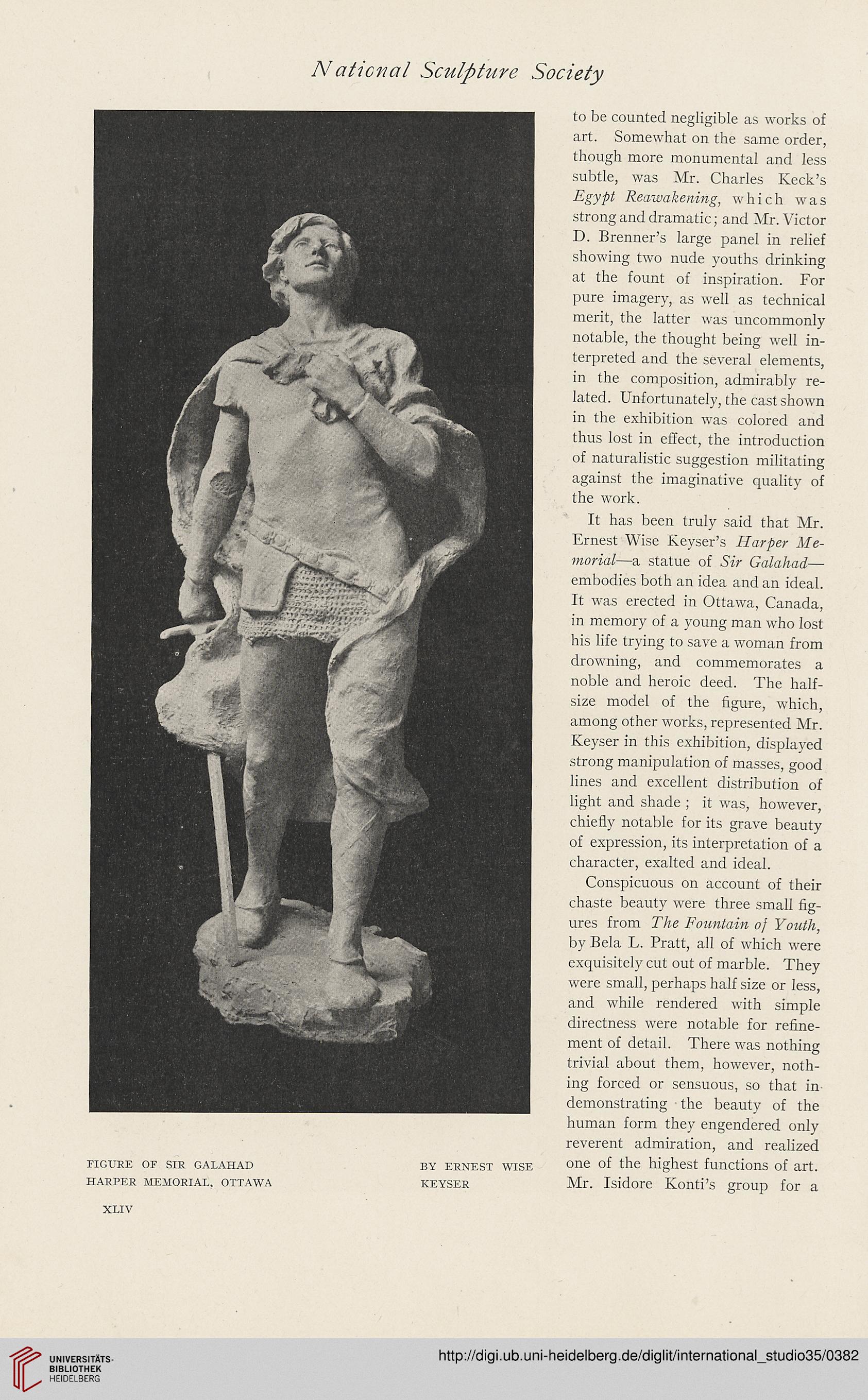A1 aticnal Sculpture Society
FIGURE OF SIR GALAHAD BY ERNEST WISE
HARPER MEMORIAL, OTTAWA KEYSER
to be counted negligible as works of
art. Somewhat on the same order,
though more monumental and less
subtle, was Mr. Charles Keck’s
Egypt Reawakening, which was
strong and dramatic; and Mr. Victor
D. Brenner’s large panel in relief
showing two nude youths drinking
at the fount of inspiration. For
pure imagery, as well as technical
merit, the latter was uncommonly
notable, the thought being well in-
terpreted and the several elements,
in the composition, admirably re-
lated. Unfortunately, the cast shown
in the exhibition was colored and
thus lost in effect, the introduction
of naturalistic suggestion militating
against the imaginative quality of
the work.
It has been truly said that Mr.
Ernest Wise Keyser’s Harper Me-
morial—a statue of Sir Galahad—
embodies both an idea and an ideal.
It was erected in Ottawa, Canada,
in memory of a young man who lost
his life trying to save a woman from
drowning, and commemorates a
noble and heroic deed. The half-
size model of the figure, which,
among other works, represented Mr.
Keyser in this exhibition, displayed
strong manipulation of masses, good
lines and excellent distribution of
light and shade ; it was, however,
chiefly notable for its grave beauty
of expression, its interpretation of a
character, exalted and ideal.
Conspicuous on account of their
chaste beauty were three small fig-
ures from The Fountain of Youth,
by Bela L. Pratt, all of which were
exquisitely cut out of marble. They
were small, perhaps half size or less,
and while rendered with simple
directness were notable for refine-
ment of detail. There was nothing
trivial about them, however, noth-
ing forced or sensuous, so that in
demonstrating the beauty of the
human form they engendered only
reverent admiration, and realized
one of the highest functions of art.
Mr. Isidore Konti’s group for a
XLIV
FIGURE OF SIR GALAHAD BY ERNEST WISE
HARPER MEMORIAL, OTTAWA KEYSER
to be counted negligible as works of
art. Somewhat on the same order,
though more monumental and less
subtle, was Mr. Charles Keck’s
Egypt Reawakening, which was
strong and dramatic; and Mr. Victor
D. Brenner’s large panel in relief
showing two nude youths drinking
at the fount of inspiration. For
pure imagery, as well as technical
merit, the latter was uncommonly
notable, the thought being well in-
terpreted and the several elements,
in the composition, admirably re-
lated. Unfortunately, the cast shown
in the exhibition was colored and
thus lost in effect, the introduction
of naturalistic suggestion militating
against the imaginative quality of
the work.
It has been truly said that Mr.
Ernest Wise Keyser’s Harper Me-
morial—a statue of Sir Galahad—
embodies both an idea and an ideal.
It was erected in Ottawa, Canada,
in memory of a young man who lost
his life trying to save a woman from
drowning, and commemorates a
noble and heroic deed. The half-
size model of the figure, which,
among other works, represented Mr.
Keyser in this exhibition, displayed
strong manipulation of masses, good
lines and excellent distribution of
light and shade ; it was, however,
chiefly notable for its grave beauty
of expression, its interpretation of a
character, exalted and ideal.
Conspicuous on account of their
chaste beauty were three small fig-
ures from The Fountain of Youth,
by Bela L. Pratt, all of which were
exquisitely cut out of marble. They
were small, perhaps half size or less,
and while rendered with simple
directness were notable for refine-
ment of detail. There was nothing
trivial about them, however, noth-
ing forced or sensuous, so that in
demonstrating the beauty of the
human form they engendered only
reverent admiration, and realized
one of the highest functions of art.
Mr. Isidore Konti’s group for a
XLIV





